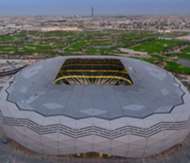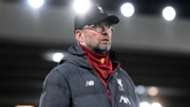Al Thawadi believes that completion of the Education City Stadium shows there are better days ahead for the footballing world...
Education City Stadium is the third World Cup Qatar 2022 tournament venue to be completed by the Supreme Committee for Delivery & Legacy (SC).
Here, SC Secretary General, H.E. Hassan Al Thawadi, discusses the stadium, the power of Qatar 2022 and ongoing preparations for the first World Cup in the Middle East and Arab world.
Q: How proud are you to have completed the third tournament venue for the World Cup Qatar 2022?
We are very proud to have completed our latest stadium. Our plans remain on track – despite the pandemic. Education City Stadium is our third tournament venue, after Khalifa International and Al Janoub, and we expect to unveil two more stadiums by the end of the year.
In many ways, I believe Qatar 2022 has become even more important due to recent events. Sport – and particularly football – has the potential to bring people together in a post-COVID-19 world. And as the next World Cup hosts, the completion of another stadium helps to lift spirits and give us all something to look forward to.
As for the stadium itself, it is an incredibly striking venue. Fans and players will love it. It’s a true football arena. The seats are very close to the pitch, so the atmosphere will be incredible. I can’t wait for the stadium to host a match with 40,000 fans present.

Q: Once the battle against COVID-19 is over, how important will major sporting events such as the World Cup be in bringing people together?
As it stands, our World Cup looks set to be one of the biggest global gatherings in the post-COVID-19 era. That will no doubt bring challenges – but at the same time it is an incredible opportunity to unite the world through our common passion for football.
This World Cup is already special – the first in the Middle East and Arab world, and the second in Asia. Now, there is an extra layer of expectation and an opportunity to provide billions of people with an unforgettable, feel-good moment.
We know that sport is unique in its power to unite and truly transcends borders. It’s one of the reasons we wanted to bring the World Cup to Qatar. We want to showcase our love for football while giving people the chance to experience a new culture. It is something we hope can contribute to dismantling stereotypes and misconceptions about our country and region.

Q: What is unique about Education City Stadium?
It’s a beautiful stadium, first and foremost, and one we call the ‘Diamond in the Desert’. The façade features diamond-like patterns which change colour according to the sun’s position – hence the nickname.
I think it’s a stadium that football fans will love. It dominates its location, which is right next to Education City Golf Club. It really stands out on the horizon and, like I said earlier, I think the atmosphere, when it’s full to capacity, will be something really special. It will be a cauldron of noise and passion during the World Cup.
The stadium’s location is also significant. It’s situated in Education City – which is home to schools and universities, along with a host of research and development organisations, among other entities. Education City is the home of Qatar Foundation, which is playing a huge role in helping our country deliver its National Vision – namely to develop a knowledge economy and shift our reliance away from hydrocarbons. This stadium is the next step in the story of Education City as it will provide facilities for this vast community both in the lead-up to the World Cup and beyond.

Q: Qatar Foundation (QF) is a key stakeholder in the World Cup project – what more can you tell us about the collaboration between the SC and QF?
I would like to pay tribute to the work of QF since its establishment and development under the leadership of Her Highness Sheikha Moza bint Nasser. Over the years, her vision and the development of QF and its impact within our society and on a global level has been pivotal in putting Qatar on the international map in the educational sphere. Education City itself is a shining light in our country’s development. It offers our citizens and residents access to some of the best universities in the world. It also houses a vast range of research and development projects and organisations. Education City already has a proud legacy and under the leadership of Her Excellency Sheikha Hind bint Hamad Al Thani, is one of the most important driving forces behind developing the knowledge economy that will benefit our country for decades to come.
Those who followed the journey of our bid to host the FIFA World Cup will remember the final presentation, in which Her Highness Sheikha Moza delivered a speech to the voters asking when the right time was for the World Cup to come to the Middle East. Her Highness told them that the time was now. Her Highness’s speech was an iconic moment for our bid. It’s fitting that almost ten years later we are launching the stadium located within QF – an entity that has blossomed into a global centre for education under the leadership of Her Highness.
QF is a valued stakeholder and will play a key role in helping us to deliver the World Cup and – importantly – support us in ensuring this tournament leaves a lasting legacy for years to come. QF will take ownership of Education City Stadium after the tournament for the benefit of its entire community – which numbers many thousands of people.
We have obviously worked very closely together throughout this project – and will continue to do so both in the lead-up to the tournament and beyond. We are very proud that a World Cup stadium will sit in the heart of Education City.

Q: What can you tell us about the sustainable features of the stadium and what will happen to it after the World Cup?
This is the only Qatar 2022 stadium so far to receive a five-star rating from the Global Sustainability Assessment System, a FIFA-approved compliance scheme which is administered by the Gulf Organisation for Research and Development.
A number of features helped it to receive this rating, including the fact that 85% of materials were regionally sourced and 29% were from recycled content. In addition, 35.5% of the building elements can be disassembled and reused – including the seats in the modular upper tier, which will be removed and donated to a country which needs sporting infrastructure after the tournament. We are very proud of this innovation – which will be replicated across several Qatar 2022 venues. It will ensure no stadium becomes a ‘white elephant’ after the tournament and ensure the legacy of our tournament is felt far and wide.
After the tournament, Education City Stadium will be a sporting facility for the QF community, including the students and faculty from the various universities based there. In addition to providing sporting facilities, some parts of the stadium will be turned into lecture halls and event spaces for QF schools and universities.

Q: How has the COVID-19 pandemic affected construction at the other sites?
Despite COVID-19, we remain ahead of schedule when it comes to delivering all the infrastructure required for the World Cup. We have actually completed 85% of construction across our portfolio and are well on course to delivering everything well in advance of the tournament.
Naturally, we have had to adapt in recent months. Strict social distancing measures have been implemented at all our sites, including construction sites and our head office in Doha. We took measures to assess our sites and ensure that any individuals at a higher risk of contracting the virus were demobilised – with pay – until COVID-19 specific health and safety measures were in place. A large number of employees have been working from home since the middle of March. The health and wellbeing of our workers remains our number one priority.

Q: How has COVID-19 affected the Supreme Committee generally? Has it been possible for legacy programmes to remain active over recent months?
I’m proud of the way all our staff have adapted in recent months. It’s been a testing time for everyone but through excellent collaboration and communication we have found a way to carry on preparing for this huge tournament.
Our legacy programmes are just one example of business continuity. Generation Amazing – our football for development programme – has been broadcasting live sessions on social media, helping to connect its vast community and inspiring them with health and fitness drills to do at home. Meanwhile, the Josoor Institute moved quickly to deliver all its professional diploma programmes online – meaning their delegates kept learning despite being stuck at home.
We’ve also worked closely with our ambassadors, including the likes of Xavi Hernandez, Cafu, Samuel Eto’o and Tim Cahill, to share key messages about social distancing and details on how to stay active, both mentally and physically, during this testing time.
We have spent significant time engaging with counterparts from within the sporting world on their challenges as they try to plan for similar-sized events, or work to restart their leagues. We’re doing everything we can to gather as much information as possible and exchange knowledge on new protocols concerning health and safety as football and sport restarts, in order to be as ready as possible for hosting the world in 2022.
We have faced challenges since the day we won the right to host the World Cup – no doubt about that – but we’ve always managed to rise to the occasion. Innovation is embedded in everything we do – whether it’s in relation to cooling technology, modular stadiums or developing the perfect grade of grass for our stadiums and training sites. Innovation and hard work have led us through the previous months and we will forge ahead with that same ethos and commitment as our journey towards 2022 and beyond continues.














